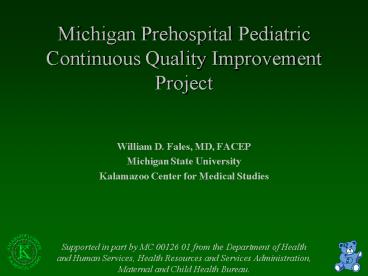Michigan Prehospital Pediatric Continuous Quality Improvement Project - PowerPoint PPT Presentation
1 / 25
Title:
Michigan Prehospital Pediatric Continuous Quality Improvement Project
Description:
Michigan Prehospital Pediatric Continuous Quality Improvement Project William D. Fales, MD, FACEP Michigan State University Kalamazoo Center for Medical Studies – PowerPoint PPT presentation
Number of Views:93
Avg rating:3.0/5.0
Title: Michigan Prehospital Pediatric Continuous Quality Improvement Project
1
Michigan Prehospital Pediatric Continuous Quality
Improvement Project
- William D. Fales, MD, FACEP
- Michigan State University
- Kalamazoo Center for Medical Studies
Supported in part by MC 00126 01 from the
Department of Health and Human Services, Health
Resources and Services Administration, Maternal
and Child Health Bureau.
2
Background
- EMS adult CQI statewide inadequate
- Virtually no pediatric CQI
- Michigans electronic EMS information system,
MERMAID was becoming established - Many local EMS systems had adopted model
pediatric prehospital protocols.
3
Traditional EMS Quality Improvement
- Typically Retrospective
- Often Case-Focused
- Review fall-out cases
- Negatively focused
- Resolutions often associated with punishment
- Not real popular with EMS personnel
4
Example of Case-Based Retrospective EMS Quality
Improvement Process
5
Medical Director Discovers Badness
6
Problem Paramedic Contacted
7
Search for Additional Problems
8
Very Thorough Search
9
Confrontation of Paramedic
10
Get Those Bad Medics Off the Street
11
Public Flogging
12
Ultimate Penalty Permanent Revocation
13
Michigan Prehospital Pediatric Continuous
Quality Improvement Project
- Goal Create a pediatric-focused CQI Model and
determine its impact on protocol compliance. - Assumption Protocol Compliance Quality
14
Methodology
- Created a CQI Model
- NHTSA Leadership Guide to Quality Improvement
- NEDARC Quality Improvement References
- Used MERMaID Electronic Medical Record
15
MERMaID
16
Methodology (cont)
- Selected 30 agencies
- Randomized into Intervention and Control Groups
- Peds vs. Adult Stroke
- CQI Workshops
- CQI Software
- Baseline Performance Data Acquired
- Monthly Aggregate Feedback to Agencies / Personnel
17
Clinical Indicators
- Created by multi-disciplinary panel
- Pediatric Indicators
- Trauma
- Respiratory distress
- Seizure
- Pain management
- Adult-Stroke
18
Results
- 30 Agencies Recruited
- 21 submitted data
- HIPPA phobia
- Smallest agencies lost
- Diverse Population
- 2 MSAs
- Kalamazoo and Saginaw
- Many rural agencies
19
Project Population
Pre-CQI Interv. Pre-CQI Control Post-CQI Interv. Post-CQI Control TOTAL
Total Patients 24,756 25,679 37,640 40,298 128,373
Ped Patients (lt16 YO) 2,129 2,199 3,237 3,457 11,022
Peds 8.6 8.5 8.6 8.5 8.6
20
Findings
- No significant differences between
- Pre- and post-CQI
- Intervention and control group
- All groups did well (gt85) with documenting
- Meds / Allergies
- Peds GCS
- Vital Signs
21
Respiratory Distress
- 6 to 11 of all pediatric patients
- O2 documented in 43 to 57 of these
- Likely a documentation issue
- Bronchodilator indicated 16-22 of resp dist.
- All received gt1 bronchodilator treatments
- EMS did very well in providing bronchodialtor
treatment!
22
Seizure
- 5 to 10 of all pediatric patients has seizure
related condition - 72-93 IV access attempted (GCSlt15)
- 81-95 Blood glucose checked (GCSlt15)
- 3-4 of Seizure related patients hypoglycemic
- 0-50 of hypoglycemics treated
- 6-13 received anti-convulsant
23
Trauma
- 16 to 19 used a Trauma protocol
- Subset of all trauma patients
- w/ Altered LOC 6-11 of those with trauma
- w/ Load and Go 7-12 of those with trauma
- gt97 spinal immobilization (when indicated)
- gt92 IV access attempted (when indicated)
- 37-52 Load and Go (lt10 min. _at_ scene)
- Rapid trauma management remains a challenge!
24
Pain Management
- 15 to 20 of all pediatric patients had
potentially painful condition - Pain scores documented 32-40 of time
- Pain score gt4
- 12-17 of those with likely pain
- 3-4 of all ped patients
- Of these 18-36 received analgesia
- Prehospital pain management remains an important
challenge!
25
Limitations
- Small numbers within all subgroups
- Use of protocol compliance as an indicator of
quality - CQI interventions varied by agency
- Most primarily provided aggregate feedback
- Limitations that could not be controlled
- e.g., medical control denied pain medication
request - These are extremely low frequency events!
26
Conclusions
- We were unable to demonstrate improved protocol
compliance using a contemporary CQI model. - Positive areas of pediatric care
- Collection of baseline patient data
- Checking blood glucose and attempting IVs
- Spinal immobilization in trauma
- Bronchodilator use in respiratory distress
- Areas in need of further efforts
- Pain management
- Rapid trauma management
27
What is the Next Step?
- MI 1st STEPPS
- Michigans First Simulation Training and
Evaluation of Paramedics in Pediatrics - 2005 EMS-C Targeted Issues Grant
- Evaluate impact of brief training every 4 months
- Compare simulation-based and non-simulation based
instruction
28
Thanks
- www.emscqi.org
- fales_at_msu.edu































